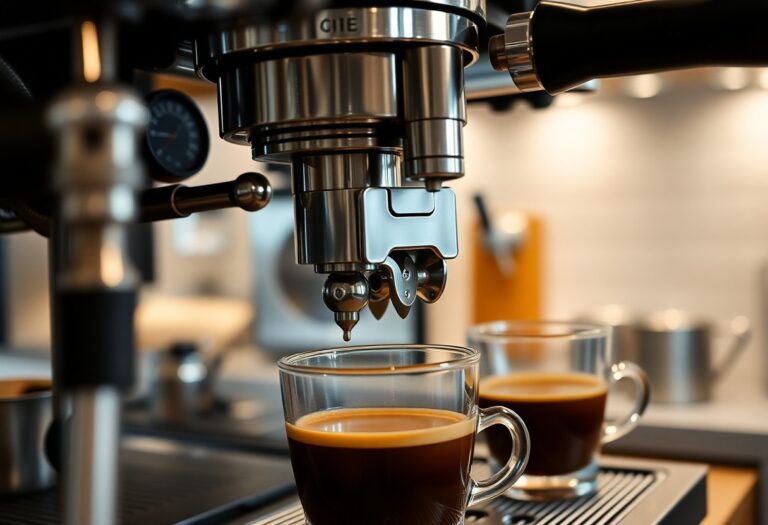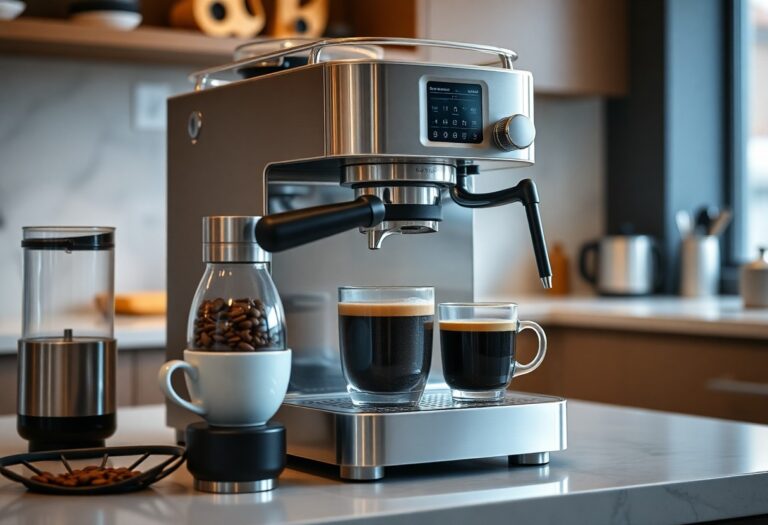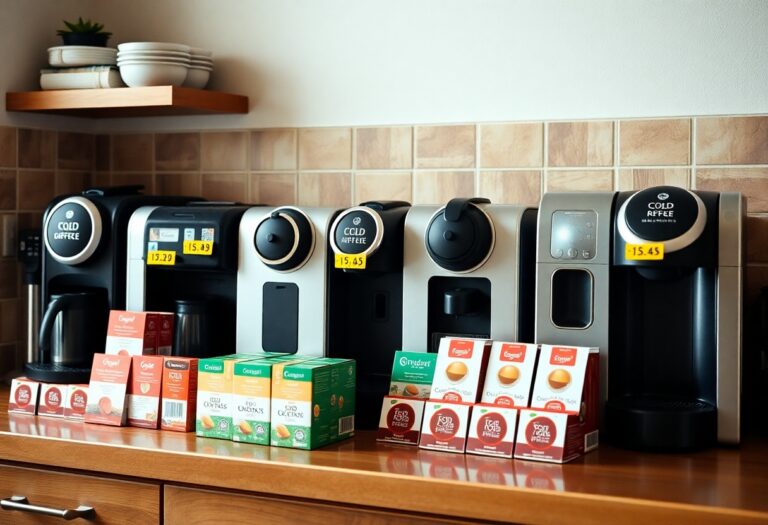What is Backflushing a Coffee Machine – Cleaning Technique
You may not realize it, but maintaining your coffee machine is crucial for brewing the perfect cup. One of the most effective cleaning techniques is backflushing, which involves reversing the flow of water through the machine’s components to remove coffee oils and residues. This method not only enhances the taste and quality of your coffee but also extends the lifespan of your equipment. Neglecting this practice can lead to malfunctioning parts and poorly extracted flavors, significantly impacting your coffee experience.
Key Takeaways:
- Backflushing is a cleaning technique used to remove coffee oils and residues from the brewing group of espresso machines.
- The process involves using a blank or blind filter basket to block water flow, forcing it back through the machine for effective cleaning.
- Regular backflushing can help maintain the flavor and quality of espresso by preventing buildup that can affect extraction.
- It is important to use the appropriate cleaning agents specifically designed for espresso machines during backflushing.
- The frequency of backflushing should be based on usage, with daily or weekly practices common for busy coffee environments.
The Mechanics of Backflushing: A Step-by-Step Breakdown
| Step | Description |
| 1. Preparation | Ensure the machine is powered off and cool. Gather necessary equipment. |
| 2. Insert Blind Filter | Replace your regular portafilter with a blind filter to prevent water flow. |
| 3. Add Cleaning Solution | Add the appropriate backflushing detergent into the blind filter. |
| 4. Run the Pump | Activate the pump briefly to build pressure, then turn it off. |
| 5. Repeat | Continue the pump cycle for several repetitions to effectively clean. |
| 6. Rinse | Remove the blind filter and rinse the group head with water. |
Equipment Required for Effective Backflushing
Gathering the right tools is crucial. You’ll need a blind filter, a high-quality backflushing detergent, and a cleaning brush designed for your machine. These items ensure that your backflushing process is thorough, effectively removing coffee oils and residue that can accumulate over time, thus maintaining the integrity of your coffee flavors.
The Backflushing Process Explained
Backflushing entails creating pressure in the brewing group to dislodge coffee oils and impurities. With the blind filter attached, water is pumped into the group head, forcing the detergent through the internal components. This process not only cleans but also helps maintain the machine’s overall performance. Regular backflushing, typically every 1-2 weeks depending on usage, is vital to prolonging your machine’s lifespan.
A time-efficient backflushing routine can yield impressive results. By running the pump for around 10-15 seconds, followed by a short rest, you allow water and cleaner to penetrate and dissolve stubborn residues. You should repeat this cycle approximately 5-10 times, helping to keep the group head and valves free from buildup. After you finish, ensure to rinse thoroughly to remove any leftover detergent, preventing contamination in your brewing process and safeguarding the taste of your coffee.

Common Mistakes to Avoid During Backflushing
Backflushing can be an effective cleaning method, but it’s easy to make mistakes that can compromise your coffee machine’s performance. Neglecting to follow the manufacturer’s guidelines or overlooking vital maintenance steps can lead to buildup that negates your efforts. Additionally, failing to consider the compatibility of cleaning products can result in damage to your machine. Avoid these pitfalls to ensure that you maintain the integrity and functionality of your equipment.
Overlooking Essential Maintenance Steps
Skipping basic maintenance routines before backflushing can lead to ineffectiveness. You should ensure that the group head is clean and that the coffee grounds are removed properly. If you don’t perform these preliminary steps, you’ll push debris further into the machine, which can clog components and reduce performance.
Ignoring Compatibility with Different Coffee Machines
Not all cleaning products are suitable for every coffee machine; using the wrong ones can cause significant damage. Different machines vary in design and function, which means the backflushing process may not be uniform across all models. Always check product compatibility with your specific coffee maker to avoid issues like component corrosion or ineffective cleaning.
If you use a cleaning solution that isn’t designed for your particular machine, you risk not just poor cleaning results but also potential harm to internal components. For example, if your machine has plastic parts, a harsher chemical could lead to degradation over time. Research and consult the manufacturer’s instructions before selecting a cleaning agent, ensuring it is designed for your model to keep your equipment in peak condition.
The Importance of Regular Backflushing: Why It Matters
Regular backflushing plays a vital role in maintaining the efficiency and functionality of your espresso machine. This technique helps clear residual coffee oils, ground particles, and other impurities from the brewing system, preventing both clogging and build-up. By committing to a consistent backflushing schedule, you ensure that each cup of coffee you brew meets the highest quality standards, delivering the rich flavors and aromas your customers or family expect.
Impact on Coffee Quality and Flavor Profiles
When you backflush regularly, the flavors in your coffee become more pronounced and consistent. Residual oils and coffee particles can lead to bitter or off-tasting brews, which detract from the intended flavor profiles. By clearing these unwanted remnants, you promote a cleaner extraction, which enhances the overall taste and aroma, ensuring every pour is as delightful as the last.
Long-Term Benefits for Your Machine’s Lifespan
Implementing a regular backflushing routine significantly extends the lifespan of your espresso machine. By proactively removing debris and buildup, you minimize wear and tear on internal components, which can lead to costly repairs or replacements over time. Machines that are well-maintained typically enjoy better performance, translating to enhanced extraction and brewing capabilities, resulting in a higher return on your initial investment.
The benefits of long-term maintenance through backflushing can be substantial. Just as you wouldn’t ignore regular oil changes in a car, neglecting your espresso machine can lead to significant performance decline. For instance, a commercial machine that’s backflushed monthly can last several years longer than one that isn’t. By establishing a regular backflushing interval—ideally after every 200 shots—you not only guard against breakdowns but also uphold the consistent quality of your brews, ultimately providing a better experience for your customers.
Debunking Myths: What Backflushing Can and Can’t Do
Many misconceptions surround backflushing, leading to confusion about its true effectiveness. While backflushing is significant for removing residual coffee oils and debris, it cannot replace a comprehensive cleaning regimen. You still need to scrub the group head and clean other components, as backflushing alone will not eliminate built-up mineral deposits from water or internal parts that require deeper attention.
Clarifying Misconceptions About Cleaning
It’s a common myth that backflushing is a catch-all solution for coffee machine maintenance. While it greatly aids in keeping the brew group clean, it does not completely prevent the need for manual scrubbing or descaling. Regular thorough cleaning is still needed to maintain optimal performance and preserve the lifespan of your machine.
Distinguishing Backflushing from Other Cleaning Techniques
Backflushing should not be confused with routine cleaning methods like wiping down surfaces or performing descaling. While those methods remove surface dirt, backflushing targets hidden buildup in the espresso machine’s group head and internal pathways. It specifically reverses the flow of water to flush out coffee residues and oils that accumulate with each shot.
Understanding the distinction is necessary for effective maintenance. Backflushing primarily internalizes the cleaning process within the brew group, while surface cleaning focuses on external components. Descaling, on the other hand, is intended to remove mineral deposits, a task that backflushing does not address. Together, these techniques ensure your coffee machine operates efficiently, producing the best flavors without compromising the internal systems.

Expert Tips for Maximizing Backflushing Efficiency
To enhance the effectiveness of your backflushing routine, consider the following tips:
- Utilize the right cleaning agents – opt for those specifically designed for espresso machines.
- Maintain consistent water temperature during backflushing to dislodge stubborn residue.
- Incorporate short cycles to prevent sediment accumulation in the group heads.
- Monitor your pressure levels to ensure optimal cleaning without damaging components.
This combination will significantly improve your backflushing effectiveness.
Best Practices for Frequency and Timing
Scheduling your backflushing sessions based on your machine’s usage is vital. For machines used daily, backflushing every day is ideal, while those used less frequently may require weekly or bi-weekly maintenance. Consider backflushing at the end of your day when the machine is powered down, allowing any buildup to become easier to clean while the machine cools.
Innovations in Cleaning Products and Techniques
Recent advancements in the coffee industry have introduced specialized cleaning products and methods for backflushing. From enzymatic cleaners that efficiently break down coffee oils to new biodegradable powders, these innovations enhance the cleaning process. Automated cleaning cycles in high-end machines allow for precise control over backflushing, ensuring optimal results with minimal oversight.
New cleaning techniques embrace technology, such as digital monitoring systems that alert you when it’s time for backflushing based on usage patterns. Additionally, eco-friendly formulations are now commonly available, minimizing environmental impact while maintaining cleaning efficacy. As these innovations advance, keeping your coffee machine clean becomes not only easier but also more effective, safeguarding the quality of every cup you serve.
Conclusion
Taking this into account, understanding backflushing a coffee machine is imperative for maintaining its performance and longevity. By implementing this cleaning technique regularly, you can ensure optimal extraction, enhance the flavor of your coffee, and prevent any buildup of coffee oils or residue. Your machine will operate more efficiently, leading to a better brewing experience. Invest a little time in backflushing, and you’ll enjoy consistently great coffee every time you brew.
FAQ
Q: What is backflushing a coffee machine?
A: Backflushing is a cleaning technique used in espresso machines that involves running water in reverse through the group head. This process helps to remove coffee oils and residue that accumulate during brewing, ensuring optimal performance and flavor extraction from the coffee.
Q: Why is backflushing important for my espresso machine?
A: Backflushing is important because it maintains the cleanliness and efficiency of your espresso machine. Regular backflushing prevents clogs, improves water flow, and ensures that your machine produces high-quality espresso. It also helps extend the lifespan of the machine by reducing buildup that could potentially damage internal components.
Q: How often should I backflush my coffee machine?
A: The frequency of backflushing depends on how often you use your espresso machine. For daily users, it is typically recommended to backflush once a day or after every few dozen shots. If you use the machine less frequently, backflushing once a week may suffice. Monitoring the flavor and quality of your espresso can also guide you in determining the appropriate frequency of backflushing.
Q: What supplies do I need to backflush my espresso machine?
A: To backflush your espresso machine, you will need a blind filter basket (a solid basket without holes) and a cleaning detergent specifically designed for coffee machines. Ensure that the detergent is safe for espresso machines. These supplies will help you effectively clean the group head during the backflushing process.
Q: What is the backflushing process like?
A: The backflushing process generally involves a few simple steps: First, turn off the machine and insert the blind filter basket into the portafilter. Add a small amount of espresso machine cleaning detergent to the blind basket. Next, attach the portafilter to the group head and activate the brew cycle for 10 seconds, then turn it off. Repeat this process several times, allowing the machine to rest for 10 seconds between each activation. Finally, rinse the group head with clean water by running a brew cycle without detergent to remove any residual cleaning solution.







